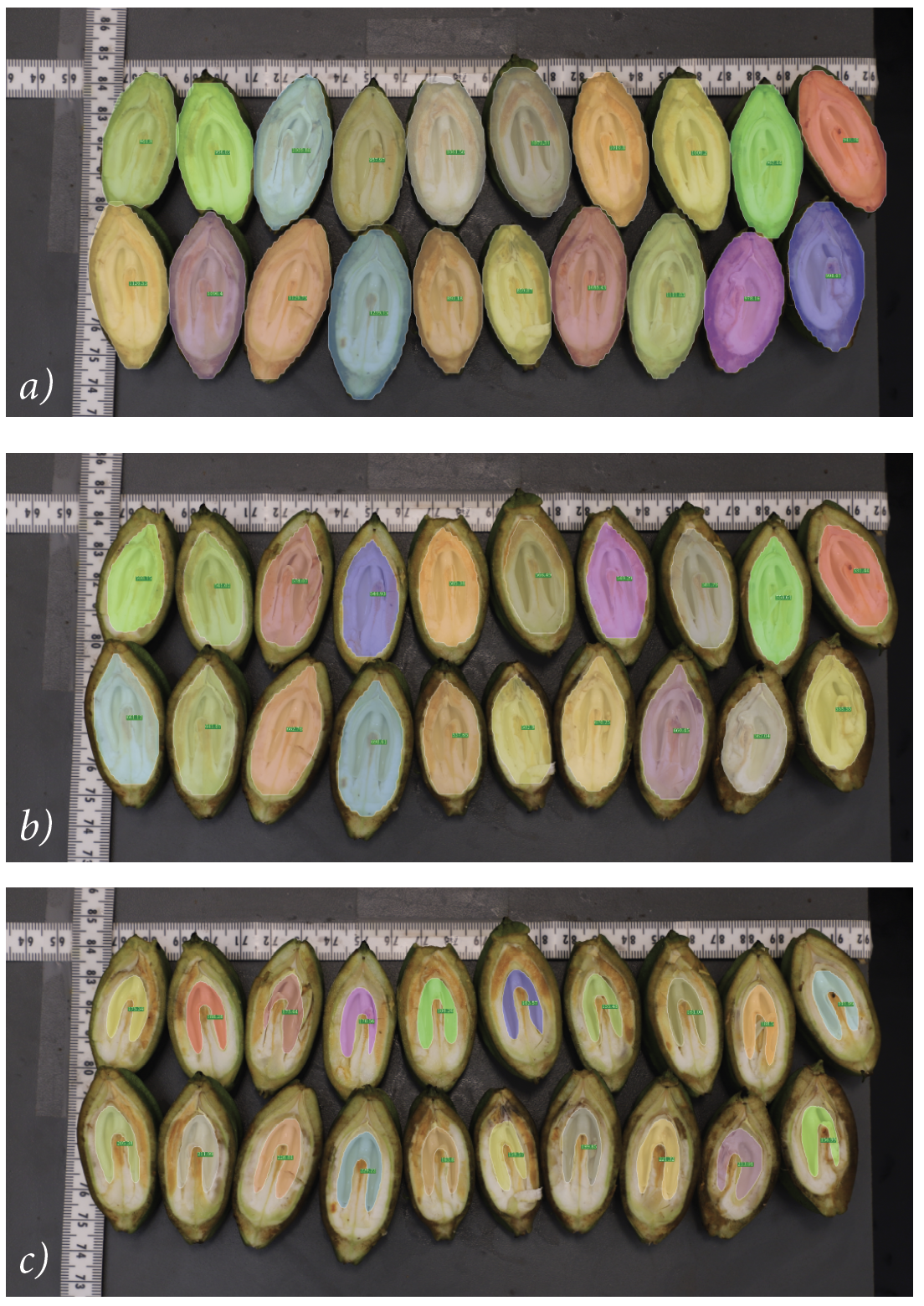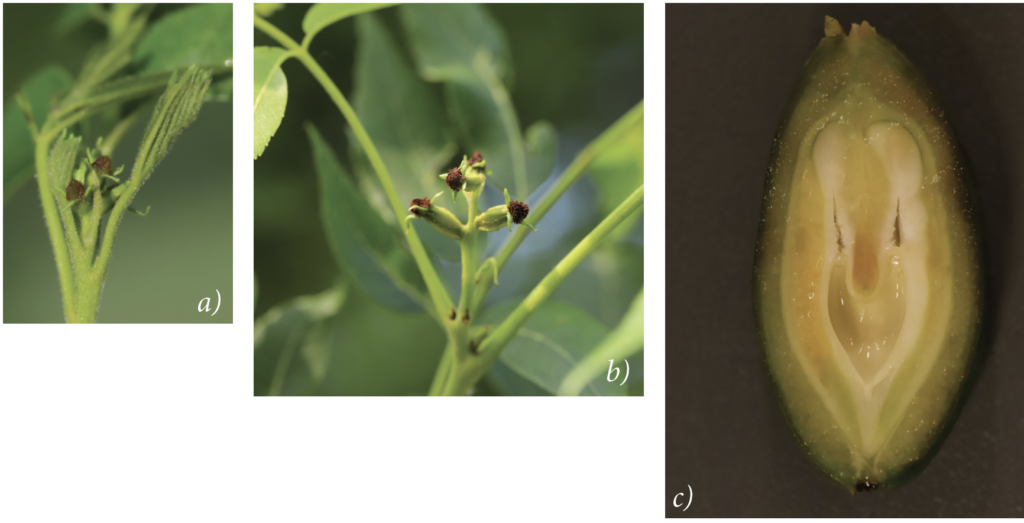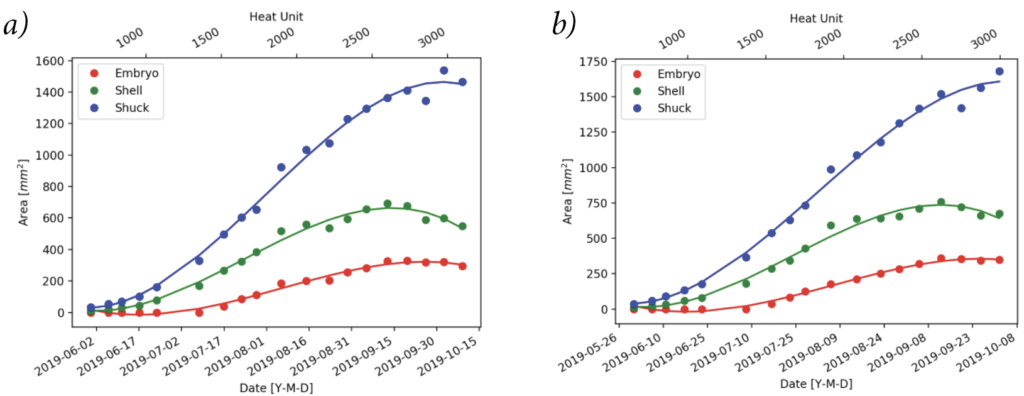Know Your Nuts – From Flowering to Fruiting
Understand the Fruit Growth Curve for Better Pecan Production

Figure 1 shows the measurement method of the areas of shuck (a), shell (b) and embryo (c). To define the area of interest of each element (embryo, shell and shuck), an algorithm was developed based on the Mask R-CNN, a convolutional neural network that works in two steps. The first step is the object detection, namely Faster R-CNN, where the element is identified and a region of interest where it is inserted is defined. The second step is the actual Mask R-CNN, where the bounds and the area of the element is defined. The area given in number of pixels is later transformed to millimeters squared using a metric tape contained on all pictures, where the size of each pixel is measured by counting the number of pixels there is in a 10 millimeters distance.
But why is a phenological model so important? Consider this as taking a newborn in for their first physical examination; you may be nervous until you receive an evaluation from the doctor and see that your child is on a normal growth curve, one on par with the model offered by the World Health Organization. Accordingly, the doctor may give suggestions if your child does not meet these expectations. For example, the doctor might recommend increasing vitamin D consumption to accelerate calcium absorption if the child’s height is stunted. Yes, our pecans need to be babied similarly—with the guidance of a growth model.
To lay the groundwork for such a model, we observed and measured ‘Pawnee,’ ‘Kanza,’ and natives’ (marked trees) pecan nut growth within six locations from southeastern to northeastern Oklahoma: Idabel, McMillian, Burneyville, Perkins, Cleveland, and Skiatook. Nuts were collected weekly (in Perkins) or biweekly (in other locations), and the area of nut shuck, shell, and embryo in longitudinal sections were calculated through developing an algorithm based on a convolutional neural network Mask R-CNN (Fig 1). Hourly temperatures were collected by Onset HOBO® data loggers installed at each location.
Initiation of a Nut
Fruits are developed from flowers. Pecans are a monoecious species where male and female flowers exist as separate structures on the same tree. But unlike male flowers where each shoot could produce 15 million pollen grains, there are usually only three to six female flowers in the terminal of the fruiting shoot (Fig 2a). Each female flower has three functional structures: stigma, style, and ovary. The stigma takes charge in recognizing compatible pollen and stimulates pollen tube germination, which will travel through the style delivering two sperms (higher plants, e.g., pecan) to the ovule, located inside the ovary. The wall of the ovary has three layers: exocarp, mesocarp, and endocarp. Exocarp and mesocarp will develop into the shuck while the endocarp will develop into the shell.
Within the ovule, one of the sperms will unite with the egg cell to produce a zygote, while another one will unite with a special cell to initiate endosperm. In the pecan, zygotes will develop into the embryo, which contains cotyledons and axis. Cotyledons are the meat we consume; the endosperm is a tissue providing nutrients to the growth of the cotyledon and will later degenerate.
In fact, the liquid during the water stage is pecan’s endosperm. Pecan endosperm belongs to the nuclear endosperm family, which is also called noncellular endosperm, which means that it produces multiple or numerous nuclei before it forms cell walls to enclose each nucleus.
The plant wall frames plant cells, and each cell has only one nucleus, which contains DNA and controls the whole cell’s metabolism. Most cell division processes synchronously produce the same amount of cell wall frame and nucleus. Nuclear endosperm is a special cell division type that causes a lot of nuclei to float in the same substrate (jelly or liquid) and later, the formation of the cell wall will produce cellular endosperm tissues. Another example of this liquid endosperm is coconut water. We assume that in pecans, the materials in the gel stage, which is the stage after the water stage, could be the formation of cellular endosperm, but further research is required. The later dough stage shows the gel materials are fully absorbed and disappear; the cotyledon becomes thick in preparation for oil filling, one of the final events leading to nut maturity.
Heat Unit
Temperature controls and fine-tunes a plant’s developmental rate. Unlike warm-blooded animals, plants stop or slow down growth when the temperature is too hot or too cold; temperatures directly regulate plant enzymes involved in metabolic activities. Because of this, heat units—as the accumulation of affected temperatures—are more precise than calendar days for indicating nut growth.

Figure 2: Flower and nut stages of Pawnee cultivar. The first photo (a) shows bloom, the stage we start to calculate heat unit. Next, (b) during the small fruit stage, the heat unit is at 200. Lastly, liquid endosperm (c) is observed marking the start of the water stage.
Some research in pecan and other nut crops reveals that a tree’s growth ceases at about 44 degrees Fahrenheit. We conservatively used this value as a “base” temperature (the lowest temperature at which growth will occur) in the current heat unit calculation. Heat units were determined by taking daily averages and removing its base temperature of 44.6 degrees Fahrenheit. In fact, plants require a higher temperature to implement certain metabolic processes; for example, carbohydrate (food) allocation occurs above 58.1 degrees Fahrenheit in pistachios (Dr. Maciej Zwieniecki). The values of the base, optimum, and critical temperatures for heat unit calculation in pecans are sorely needed and should be established based on plant physiological experiments.
We designated that when 80 percent of the female flowers on the trees reached the flowering stage (Fig 2a), the start of fruiting occurred, and the accumulation of heat units started from there. In Perkins, ‘Pawnee’ entered this bloom stage on May 6 and ‘Kanza’ on May 9. Figure 2b shows small pecan fruits with a heat accumulation of 220 heat units when the decayed stigma was still visible.
We counted nuts at the water stage once liquid endosperm was observed (Fig 2c); ‘Pawnee’ and ‘Kanza’ both showed this at 1200 heat units. Our definition of water stage is earlier than the method used by Dr. William Reid, who says that the water stage is when the kernel seed coat becomes full-sized and the interior of the kernel fills with liquid endosperm. In this way, our definition extended the period of the water stage, and therefore, a scale of seed coat size with liquid endosperm should be defined in our model. Nuts entered the gel stage at 1750 heat units and into the dough stage at 2000 heat units.

Figure 3: Embryo, shell, and shuck development of ‘Kanza’ (a) and ‘Pawnee’ (b) cultivar in Perkins. The lower x-axis is the sampling date and the upper x-axis is the heat unit calculated from bloom with a base temperature of 44.6 degrees Fahrenheit. The three elements show slow nut growth at earlier stages and increase growth at later stages between 1200 to 2000 heat unit, which lasts through the water stage and gel stage. Embryo initiates later than shuck and shell; the growth of which is visible at 730 heat unit in ‘Kanza’ and 770 heat unit in ‘Pawnee.’ Shell size dropped above 2300 heat unit.
Nut Growth
Fig 3a and 3b show the growth tendency of nut shuck, shell, and embryo of ‘Kanza’ and ‘Pawnee’ cultivars in Perkins based on average values; each dot in the graph stands for a measurement of 30 nuts. The growth curves indicated a non-linear growth: the development rate of the three components of growth changed with the increase of heat units. Shuck, shell, and embryo all start growth slowly at the beginning but grow relatively fast from 1200 to 2000 heat units, which is between the initiation of the water stage and the end of the gel stage. The nut’s growth slows once the embryo enters the dough stage.
Embryo was in a stationary state until 730 heat units in ‘Kanza’ and 770 heat units in ‘Pawnee’ after fertilization. It is common in some tree fruit species that the zygote needs a period to prepare for cell division and elongation of the embryo development.
Interestingly, we found the shell size dropped in both ‘Pawnee’ and ‘Kanza’ nuts after 2300 heat units. This finding reveals that pecan nuts are dried on trees before harvest. From the growth curves, it is tempting to speculate that the shell-out percentage increases when close to the end of the season. Our data is based on the size of areas instead of weight; since oil is laid down after cotyledons have fully formed (and oil represents about 70 percent of the weight impacting shell-out percentage), our data indicate the limits of shell-out percentage rather than the actual number.
Cultivars and Locations
From the data collected at Perkins, we didn’t see a big difference in nut development between ‘Pawnee’ and ‘Kanza’ cultivars. The growth curves of all three elements (shuck, shell, and embryo) were extremely similar to each other though the nut sizes were different. ‘Pawnee’ typically blooms three to four days earlier and is harvested six to seven days earlier than ‘Kanza.’ The two cultivars entered the water stage, gel stage, and dough stage at similar heat units; both are ready for harvest at 2700 heat units in 2019.
With the support of Oklahoma pecan growers, we also collected nut growth data of ‘Pawnee’ and ‘Kanza’ from five other locations. The nut growth will be compared among geographic locations within each cultivar.
We plan to continue this research in two steps: 1. Modeling pecan nut growth across many locations and cultivars, developing a conceptual website for pecan growers using heat unit as an index of nut growth; 2. Fitting light, rainfall, soil, and other factors into the model to fine-tune the prediction of nut growth in the future. Ideally, growers will only need to input information of bloom date, cultivar, and orchard location; the in-time nut growth situation will be reported, and the future growth conditions will be foreseen through interpreting local weather forecasts to time sprays and irrigation for optimum yield in that season.
The conceptual website for nut growth prediction is scheduled to release before the pecan bloom of this coming year. We will publish our research progress periodically; please look for updates in upcoming Pecan South issues.

